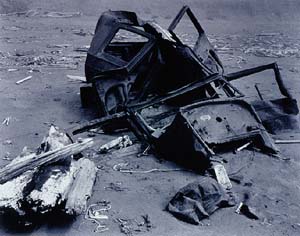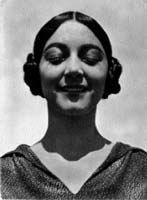The one aspect of Gay's description of modernism that might apply to Weston's work is his idea of a 'revolt against the fathers.' Gay describes modernists as engaging in a
 Freudian struggle with their fathers that took the form of a self-conscious rejection of tradition and convention. While I do not know enough about Weston to speculate on the Freudian aspect of Gay's interpretation (that is, whether or not Weston had it out for his actual father), I can see how his art arguably constitutes a willful revolt against the past, at least to the extent that 'past' consisted of photography's limiting itself to portraiture and journalism, or, more precisely, to the recording what one generally saw, a face, a place, a moment in time, and a bid to represent a surface reality as the viewer directly observed it. The French master Nadar's careful portraits enable me to see the part in the hair, the look in the eye, the creases around the mouth, and
the ruffles in the necktie of statesmen and celebrities long dead.
In contrast, Weston's work offers to reveal the invisible, to provide a vision of some deeper reality. His nudes, for example, make us see not the thigh but a line, not the breast but a curve. Everything in his photographs was there all along, available to any who behold a naked body. Yet in discarding a pre-modernist emphasis on 'reality,' Weston succeeds in showing us something new, something hidden, something wonderfully beautiful.
Freudian struggle with their fathers that took the form of a self-conscious rejection of tradition and convention. While I do not know enough about Weston to speculate on the Freudian aspect of Gay's interpretation (that is, whether or not Weston had it out for his actual father), I can see how his art arguably constitutes a willful revolt against the past, at least to the extent that 'past' consisted of photography's limiting itself to portraiture and journalism, or, more precisely, to the recording what one generally saw, a face, a place, a moment in time, and a bid to represent a surface reality as the viewer directly observed it. The French master Nadar's careful portraits enable me to see the part in the hair, the look in the eye, the creases around the mouth, and
the ruffles in the necktie of statesmen and celebrities long dead.
In contrast, Weston's work offers to reveal the invisible, to provide a vision of some deeper reality. His nudes, for example, make us see not the thigh but a line, not the breast but a curve. Everything in his photographs was there all along, available to any who behold a naked body. Yet in discarding a pre-modernist emphasis on 'reality,' Weston succeeds in showing us something new, something hidden, something wonderfully beautiful.
The communication of hidden truths via new perspectives is a practice commonly associated with modernism. The curators cleverly emphasize the point by including among Weston's work similar pieces by contemporaries such as Georgia O'Keefe and the photographer Imogen Cunningham. Cunningham's most memorable work in the Weston exhibit is a close-cropped photograph of the torso of a sitting female nude. Bearing the title, "Triangles," Cunningham's picture of the lines of the torso, at once gestures towards abstraction and communicates a vision of beauty we mortals would not have seen had we stood next to the photographer in her studio and gazed at the model with her. Weston and contemporaries like Cunningham seem to have shared an approach to aesthetics and perception that was part of a self-conscious movement intent upon innovation. This, perhaps, is modernism.
 And yet, in many of Weston's other photographs, 'modernism' is harder to see. Multiple pictures of Mexican sights suggest simple exoticism. Images from Weston's last decade of productivity, the 1940s, are whimsical, lighthearted, and sometimes ironic. (The Phillips curators, who share the commonplace assumption that irony is proof of sophistication, rush to see in these pictures evidence of Dada or Surrealism. I think they're just playful.) In fact, looking at Weston's sunny pictures I began to question whether any American artist, particularly someone who lived as well as Weston did, could have more than a superficial connection with cultural trends so closely bound up with the traumas of Europe. The distance between Weimar Germany and Carmel, California is vast.
And yet, in many of Weston's other photographs, 'modernism' is harder to see. Multiple pictures of Mexican sights suggest simple exoticism. Images from Weston's last decade of productivity, the 1940s, are whimsical, lighthearted, and sometimes ironic. (The Phillips curators, who share the commonplace assumption that irony is proof of sophistication, rush to see in these pictures evidence of Dada or Surrealism. I think they're just playful.) In fact, looking at Weston's sunny pictures I began to question whether any American artist, particularly someone who lived as well as Weston did, could have more than a superficial connection with cultural trends so closely bound up with the traumas of Europe. The distance between Weimar Germany and Carmel, California is vast.
The photographs included in the Phillips Collection leave no doubt that Weston was a master. Was he a modernist? Sometimes. Sort of. He was if modernism is understood quite simply as a self-conscious bid to innovate and to reveal a truth that was otherwise invisible. He was because he and his colleagues regarded themselves as such. Or because those who considered themselves modern regarded his work as representative of what they were all about. But think of all those in history who might fit that definition. Voltaire. Hegel. Jimi Hendrix. So perhaps modernism should be limited historically, and refer only to those identified with the avant garde in the period between, say, the Vienna Succession and Hiroshima. Of course, that's still an awful lot of people and an impossibly diverse array of artistic trends.
I left the Phillips as befuddled as I had been when I came in. But I am glad I went and became acquainted with Weston's great art. Perhaps the museum's attempt - and my own - to somehow explain or aggrandize his achievement by attaching labels to him does him a tremendous disservice? I suspect we've missed the point of his art entirely.
|
|
Edward Weston, Driftwood and Auto (1939), Museum of Fine Arts, Boston
Edward Weston, Rose Covarrubias (1926), Museum of Fine Arts, Boston
What's the difference between laughing with art and laughing at it?
June, 2002
At college drawing classes, looking for the real art among the posing.
May, 2002
What draws protesters to shout about banal holocaust art?
April, 2002



film politics music jay's head poetry art josh ring saddies about archive